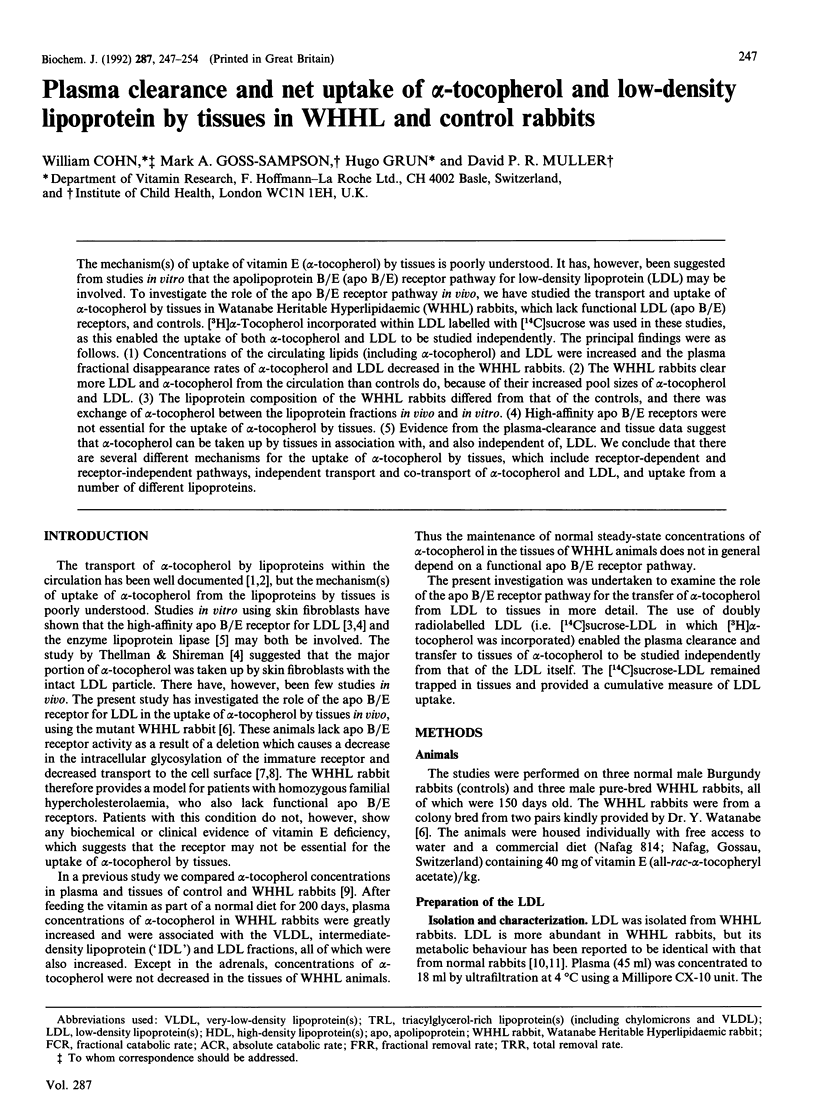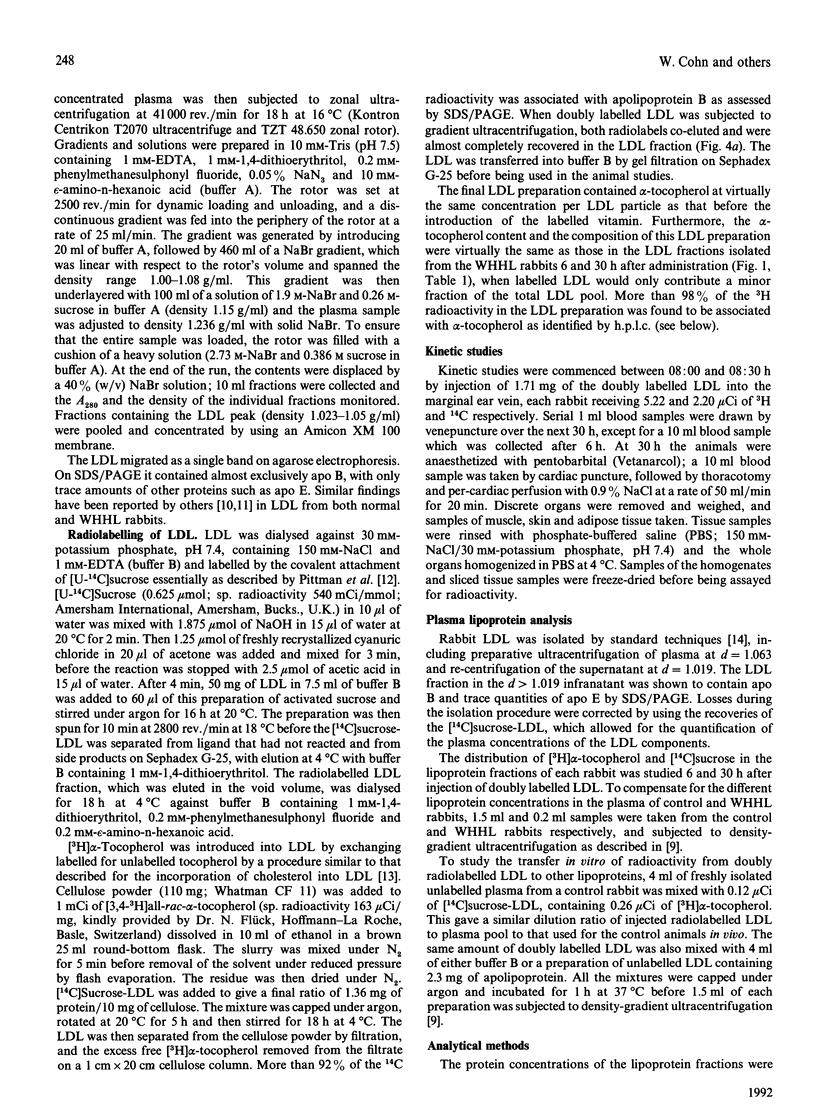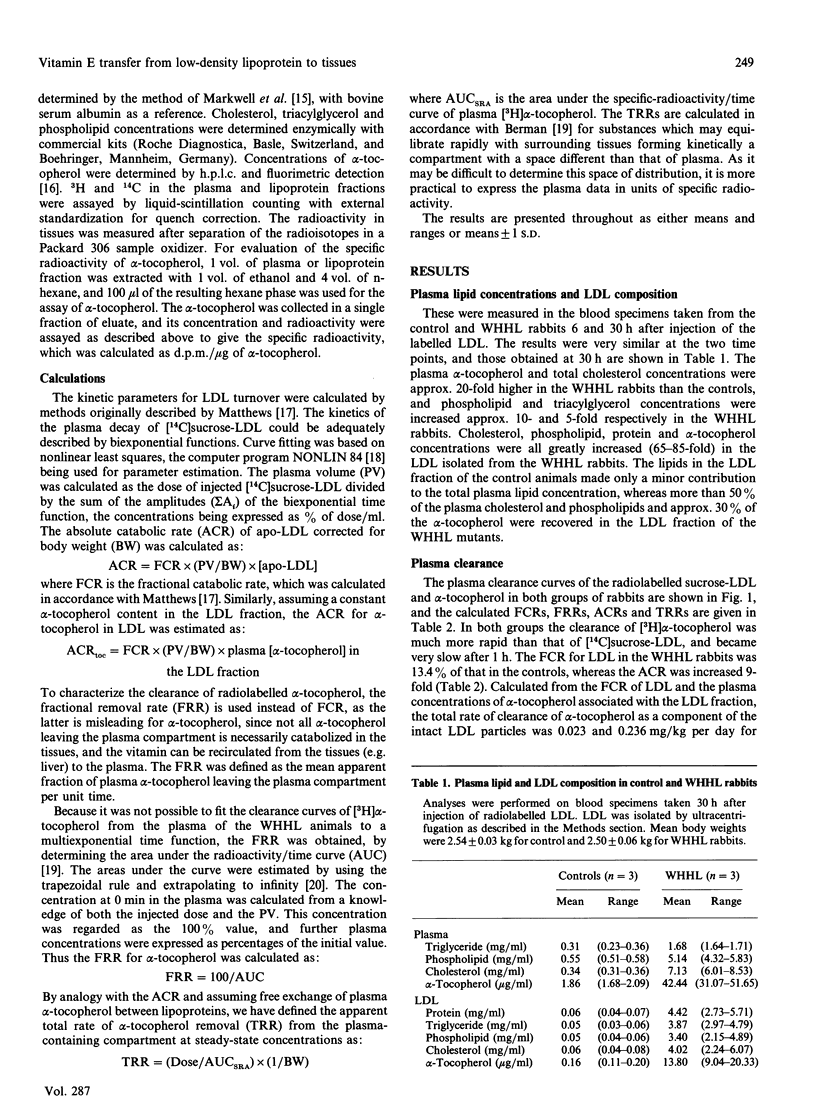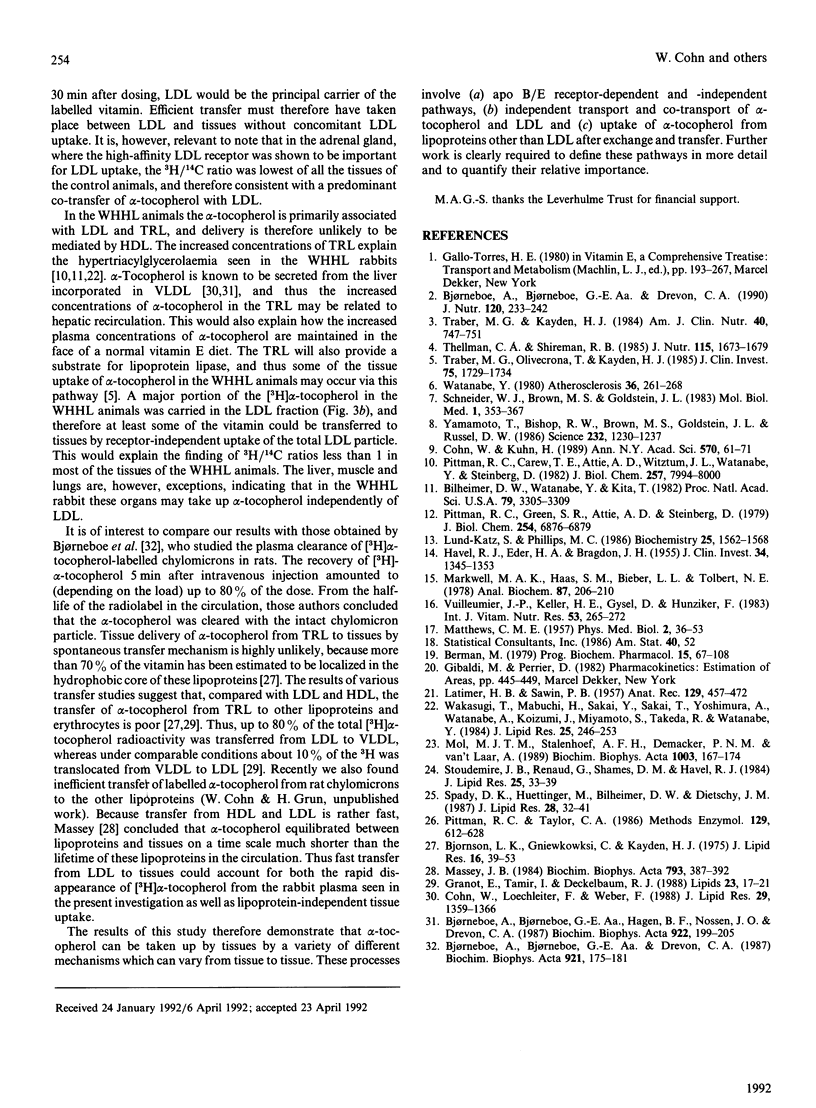Abstract
The mechanism(s) of uptake of vitamin E (alpha-tocopherol) by tissues is poorly understood. It has, however, been suggested from studies in vitro that the apolipoprotein B/E (apo B/E) receptor pathway for low-density lipoprotein (LDL) may be involved. To investigate the role of the apo B/E receptor pathway in vivo, we have studied the transport and uptake of alpha-tocopherol by tissues in Watanabe Heritable Hyperlipidaemic (WHHL) rabbits, which lack functional LDL (apo B/E) receptors, and controls. [3H]alpha-Tocopherol incorporated within LDL labelled with [14C]sucrose was used in these studies, as this enabled the uptake of both alpha-tocopherol and LDL to be studied independently. The principal findings were as follows. (1) Concentrations of the circulating lipids (including alpha-tocopherol) and LDL were increased and the plasma fractional disappearance rates of alpha-tocopherol and LDL decreased in the WHHL rabbits. (2) The WHHL rabbits clear more LDL and alpha-tocopherol from the circulation than controls do, because of their increased pool sizes of alpha-tocopherol and LDL. (3) The lipoprotein composition of the WHHL rabbits differed from that of the controls, and there was exchange of alpha-tocopherol between the lipoprotein fractions in vivo and in vitro. (4) High-affinity apo B/E receptors were not essential for the uptake of alpha-tocopherol by tissues. (5) Evidence from the plasma-clearance and tissue data suggest that alpha-tocopherol can be taken up by tissues in association with, and also independent of, LDL. We conclude that there are several different mechanisms for the uptake of alpha-tocopherol by tissues, which include receptor-dependent and receptor-independent pathways, independent transport and co-transport of alpha-tocopherol and LDL, and uptake from a number of different lipoproteins.
Full text
PDF







Selected References
These references are in PubMed. This may not be the complete list of references from this article.
- Berman M. Kinetic analysis of turnover data. Prog Biochem Pharmacol. 1979;15:67–108. [PubMed] [Google Scholar]
- Bilheimer D. W., Watanabe Y., Kita T. Impaired receptor-mediated catabolism of low density lipoprotein in the WHHL rabbit, an animal model of familial hypercholesterolemia. Proc Natl Acad Sci U S A. 1982 May;79(10):3305–3309. doi: 10.1073/pnas.79.10.3305. [DOI] [PMC free article] [PubMed] [Google Scholar]
- Bjornson L. K., Gniewkowski C., Kayden H. J. Comparison of exchange of alpha-tocopherol and free cholesterol between rat plasma lipoproteins and erythrocytes. J Lipid Res. 1975 Jan;16(1):39–53. [PubMed] [Google Scholar]
- Bjørneboe A., Bjørneboe G. E., Drevon C. A. Absorption, transport and distribution of vitamin E. J Nutr. 1990 Mar;120(3):233–242. doi: 10.1093/jn/120.3.233. [DOI] [PubMed] [Google Scholar]
- Bjørneboe A., Bjørneboe G. E., Drevon C. A. Serum half-life, distribution, hepatic uptake and biliary excretion of alpha-tocopherol in rats. Biochim Biophys Acta. 1987 Sep 25;921(2):175–181. doi: 10.1016/0005-2760(87)90016-6. [DOI] [PubMed] [Google Scholar]
- Bjørneboe A., Bjørneboe G. E., Hagen B. F., Nossen J. O., Drevon C. A. Secretion of alpha-tocopherol from cultured rat hepatocytes. Biochim Biophys Acta. 1987 Nov 21;922(2):199–205. doi: 10.1016/0005-2760(87)90155-x. [DOI] [PubMed] [Google Scholar]
- Cohn W., Kuhn H. The role of the low density lipoprotein receptor for alpha-tocopherol delivery to tissues. Ann N Y Acad Sci. 1989;570:61–71. doi: 10.1111/j.1749-6632.1989.tb14908.x. [DOI] [PubMed] [Google Scholar]
- Cohn W., Loechleiter F., Weber F. Alpha-tocopherol is secreted from rat liver in very low density lipoproteins. J Lipid Res. 1988 Oct;29(10):1359–1366. [PubMed] [Google Scholar]
- Granot E., Tamir I., Deckelbaum R. J. Neutral lipid transfer protein does not regulate alpha-tocopherol transfer between human plasma lipoproteins. Lipids. 1988 Jan;23(1):17–21. doi: 10.1007/BF02535298. [DOI] [PubMed] [Google Scholar]
- HAVEL R. J., EDER H. A., BRAGDON J. H. The distribution and chemical composition of ultracentrifugally separated lipoproteins in human serum. J Clin Invest. 1955 Sep;34(9):1345–1353. doi: 10.1172/JCI103182. [DOI] [PMC free article] [PubMed] [Google Scholar]
- LATIMER H. B., SAWIN P. B. Morphogenetic studies of the rabbit. XIX. Organ size in relation to body size in large race III and in small race X. Anat Rec. 1957 Dec;129(4):457–472. doi: 10.1002/ar.1091290408. [DOI] [PubMed] [Google Scholar]
- Lund-Katz S., Phillips M. C. Packing of cholesterol molecules in human low-density lipoprotein. Biochemistry. 1986 Apr 8;25(7):1562–1568. doi: 10.1021/bi00355a016. [DOI] [PubMed] [Google Scholar]
- MATTHEWS C. M. The theory of tracer experiments with 131I-labelled plasma proteins. Phys Med Biol. 1957 Jul;2(1):36–53. doi: 10.1088/0031-9155/2/1/305. [DOI] [PubMed] [Google Scholar]
- Markwell M. A., Haas S. M., Bieber L. L., Tolbert N. E. A modification of the Lowry procedure to simplify protein determination in membrane and lipoprotein samples. Anal Biochem. 1978 Jun 15;87(1):206–210. doi: 10.1016/0003-2697(78)90586-9. [DOI] [PubMed] [Google Scholar]
- Massey J. B. Kinetics of transfer of alpha-tocopherol between model and native plasma lipoproteins. Biochim Biophys Acta. 1984 May 11;793(3):387–392. doi: 10.1016/0005-2760(84)90253-4. [DOI] [PubMed] [Google Scholar]
- Mol M. J., Stalenhoef A. F., Demacker P. N., van't Laar A. Low-density lipoprotein catabolism in WHHL rabbits after partial ileal bypass surgery. Biochim Biophys Acta. 1989 Jun 8;1003(2):167–174. doi: 10.1016/0005-2760(89)90251-8. [DOI] [PubMed] [Google Scholar]
- Pittman R. C., Carew T. E., Attie A. D., Witztum J. L., Watanabe Y., Steinberg D. Receptor-dependent and receptor-independent degradation of low density lipoprotein in normal rabbits and in receptor-deficient mutant rabbits. J Biol Chem. 1982 Jul 25;257(14):7994–8000. [PubMed] [Google Scholar]
- Pittman R. C., Green S. R., Attie A. D., Steinberg D. Radiolabeled sucrose covalently linked to protein. A device for quantifying degradation of plasma proteins catabolized by lysosomal mechanisms. J Biol Chem. 1979 Aug 10;254(15):6876–6879. [PubMed] [Google Scholar]
- Pittman R. C., Taylor C. A., Jr Methods for assessment of tissue sites of lipoprotein degradation. Methods Enzymol. 1986;129:612–628. doi: 10.1016/0076-6879(86)29094-1. [DOI] [PubMed] [Google Scholar]
- Schneider W. J., Brown M. S., Goldstein J. L. Kinetic defects in the processing of the low density lipoprotein receptor in fibroblasts from WHHL rabbits and a family with familial hypercholesterolemia. Mol Biol Med. 1983 Oct;1(3):353–367. [PubMed] [Google Scholar]
- Spady D. K., Huettinger M., Bilheimer D. W., Dietschy J. M. Role of receptor-independent low density lipoprotein transport in the maintenance of tissue cholesterol balance in the normal and WHHL rabbit. J Lipid Res. 1987 Jan;28(1):32–41. [PubMed] [Google Scholar]
- Stoudemire J. B., Renaud G., Shames D. M., Havel R. J. Impaired receptor-mediated catabolism of low density lipoproteins in fasted rabbits. J Lipid Res. 1984 Jan;25(1):33–39. [PubMed] [Google Scholar]
- Thellman C. A., Shireman R. B. In vitro uptake of [3H]alpha-tocopherol from low density lipoprotein by cultured human fibroblasts. J Nutr. 1985 Dec;115(12):1673–1679. doi: 10.1093/jn/115.12.1673. [DOI] [PubMed] [Google Scholar]
- Traber M. G., Kayden H. J. Vitamin E is delivered to cells via the high affinity receptor for low-density lipoprotein. Am J Clin Nutr. 1984 Oct;40(4):747–751. doi: 10.1093/ajcn/40.4.747. [DOI] [PubMed] [Google Scholar]
- Traber M. G., Olivecrona T., Kayden H. J. Bovine milk lipoprotein lipase transfers tocopherol to human fibroblasts during triglyceride hydrolysis in vitro. J Clin Invest. 1985 May;75(5):1729–1734. doi: 10.1172/JCI111883. [DOI] [PMC free article] [PubMed] [Google Scholar]
- Vuilleumier J. P., Keller H. E., Gysel D., Hunziker F. Clinical chemical methods for the routine assessment of the vitamin status in human populations. Part I: The fat-soluble vitamins A and E, and beta-carotene. Int J Vitam Nutr Res. 1983;53(3):265–272. [PubMed] [Google Scholar]
- Wakasugi T., Mabuchi H., Sakai Y., Sakai T., Yoshimura A., Watanabe A., Koizumi J., Miyamoto S., Takeda R., Watanabe Y. ApoVLDL of the Watanabe Heritable Hyperlipidemic rabbit and the cholesterol-fed rabbit. J Lipid Res. 1984 Mar;25(3):246–253. [PubMed] [Google Scholar]
- Watanabe Y. Serial inbreeding of rabbits with hereditary hyperlipidemia (WHHL-rabbit). Atherosclerosis. 1980 Jun;36(2):261–268. doi: 10.1016/0021-9150(80)90234-8. [DOI] [PubMed] [Google Scholar]
- Yamamoto T., Bishop R. W., Brown M. S., Goldstein J. L., Russell D. W. Deletion in cysteine-rich region of LDL receptor impedes transport to cell surface in WHHL rabbit. Science. 1986 Jun 6;232(4755):1230–1237. doi: 10.1126/science.3010466. [DOI] [PMC free article] [PubMed] [Google Scholar]


